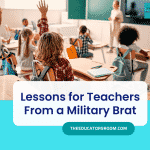An Interview With Art Teacher, Jan Barzottini
Have you signed up for The Educator’s Room Daily Newsletter? Click here and support independent journalism!
As arts programs continue to be cut across K-12 schools, I am reflecting on the importance of arts in education. In “Arts Integration in School: 10 Reasons Why It’s Important,” Sandra Larson discusses how students learn “attention to detail,” “decision making” skills, and hone “visual learning” techniques through the arts. As both an English teacher and an American Sign Language teacher of hearing students, I can appreciate the importance of these skills in a student’s educational development. Our school’s incredible art department has influenced our school’s culture and helped showcase our students’ creativity for decades. We have had, and continue to have, many incredible art teachers. So I decided to ask one of my dearest art teacher friends for her perspective.
I have worked with some incredible colleagues in every discipline over the past twenty-plus years. Jan Barzottini taught art and ceramics at our Bay Area high school for five years and now teaches art at a middle school in Texas. She made a lasting mark on our school and in my life. I think of Jan every time I see one of the many murals throughout our newly constructed campus. They are beautiful student-created pieces and also historical gems. They are memories of Jan’s effort to beautify our campus, which was made up entirely of temporary portable buildings. I recently asked Jan to weigh in on the importance of the arts in schools.
Why do we need art in school?
We need art in school because it offers students a place to exercise both sides of the brain. Succeeding at art assignments fosters confidence and gives all students an opportunity to explore different ideas, ultimately finding something they are really good at that they [often] did not expect.
What does it look like to include the arts in our ideas of “college and career readiness”?
Art offers students the opportunity to come up with varying and multiple answers to projects. This mimics real life because there may be multiple ways to come up with solutions to the problem posed. It also exposes kids to types of careers that are possible in creative fields. such as architects, engineering, designer, marketing, graphic design, etcetera.
How can the arts advance equity in education?
We need to acknowledge the full student population and provide options for them to express their unique student voice. They can share with the class in critiques, conversations and reflections so that they are sharing their unique backgrounds and experiences sparking conversation and finding commonalities.
How did the idea of creating murals for our temporary portables project come about?
During a meeting, staff were commenting on how run down and messy the temporary campus looked and there was discussion on how to improve. That evening, I was thinking about how creating an external art gallery would create points of interest throughout the campus that would also function as landmarks and easier ways of identifying where students and visitors are on campus. It also would expose students to many museum masters that they may not have an opportunity to be exposed to yet. We started with the 20th century modern masters due to simplicity and bright color, but as we got into the project and interest grew it also included contemporary works from different regions of the world, incorporating and acknowledging the cultures present at school.
What was your initial purpose in creating it?
We wanted to beautify the school and create a walking gallery. We knew we had the talent and dedication to pull it off.
What role did the students have in it?
Students primed, painted, collaborated, traced, moved, hung, and helped curate the pieces; they were very large, four feet by six feet.
How did student choice or voice come through in the pieces?
Students identified pieces that resonated with them. Each artist received a plaque with their information on it as well as the original artist information.
How can art leave an impact or legacy on the world or the future?
Students that worked on the murals still speak of them. They were acknowledged in print, television, and web stories. The mural project grew into something much bigger than [mere] decorations. They became a talking point, and they developed a community of artists and viewers.
Why should schools make sure to have the arts in every campus?
Art rounds out the curriculum of a school. For some, it’s a safe space. They sometimes discover a hidden talent or skill they didn’t know they had. Art should be a fun, productive environment where students can express themselves creatively. Art can also teach students skills that they can use in other classes. Art class can also collaborate with any subject on campus and add a creative perspective to any presentation.
Summary
I still have an incredible piece called “This Rejection of the Conqueror” by Robert Pruitt in my classroom. It is a constant conversation piece that sparks the interest of many who visit. I have Jan Barzottini and her awesome art students to thank for creating this incredible piece that will continue to influence generations of students to come. Thank you, Jan, for your dedication to the arts, for your influence in my development as a teacher and for your continued friendship. And thank you to all teachers of the arts for the incredibly impactful ways you have all helped countless students find creative ways to express their passion, their purpose and their voices.
Editor’s Note: If you enjoyed this article, please become a Patreon supporter by clicking here.





